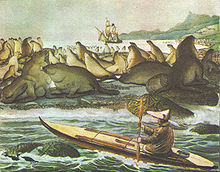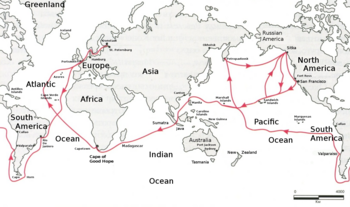Otto von Kotzebue
Otto von Kotzebue ( Russian Отто Евстафьевич Коцебу ; born December 19, jul. / 30th December 1787 greg. In Reval , Russia (now Tallinn, Estonia ); † February 3 . Jul / 15. February 1846 . Greg ibid) was a Baltic German officer in the Russian Navy and in this capacity a three-time circumnavigator and explorer .
Life
Youth and first trip around the world
Otto von Kotzebue was the second son of the Weimar poet August von Kotzebue . After the early death of her mother, Friederike von Kotzebue, née von Essen, (1763–1790), the father married a second time in 1794. Otto attended elementary school in Reval from 1793 to 1796 and then until 1801 the grammar school in Saint Petersburg. In 1801 he was sent to the St. Petersburg Naval Cadet Institute, where he graduated in 1803. In the same year he and his younger brother Moritz (1789–1861) took part in the first Russian circumnavigation of the world under Adam Johann von Krusenstern , a cousin of Otto's stepmother, on the frigate Nadeschda . The journey, the aim of which was to strengthen Russian trade in the Far East, lasted until 1806.
Then Kotzebue stayed with the Imperial Russian Navy and was promoted to boatswain , in 1811 to lieutenant. In 1812 he circumnavigated Scandinavia with Admiral Roman Wassiljewitsch Crown coming from Arkhangelsk . When the Russian-American Company was looking for a captain in 1813 to take the Suworow to its stations on the American west coast, Kotzebue applied for the job, but at the age of only 25 he appeared too young.
Second world tour 1815-1818
After the end of the Napoleonic Wars , Russia renewed its interest in being more involved in Far East trade and in reaching American possessions by a shorter route. The Russian Foreign Minister Count Nikolai Petrovich Rumjanzew privately equipped the brig Rurik for an expedition to explore the Northwest Passage . On Krusenstern's recommendation, he put Lieutenant Otto von Kotzebue in charge of the trip, in which Adelbert von Chamisso , whom Charles Darwin described as a rightly distinguished natural scientist, and Johann Friedrich von Eschscholtz and the painter Ludwig Choris (also Louis Choris ) also took part . The Rurik circumnavigated Cape Horn and reached Kamchatka on a path off the beaten track . Numerous Polynesian islands were mapped. The expedition stayed in the archipelago of the Marshall Islands for a particularly long time and returned there twice in 1817. Kotzebue's ethnographic observations form the basis of folklore knowledge of these islands to this day. In the summer of 1816 the Rurik passed the Bering Strait and Kotzebue discovered the Kotzebuesund in Alaska , where the small town of Kotzebue is named after him today. The hope that this would be the beginning of the desired passage was soon disappointed, but a protected anchorage was found for future expeditions. The winter of 1816/17 was spent in California and Hawaii . Suffering from the consequences of an injury that he sustained during a severe storm on April 13, 1817, Kotzebue had to break off the trip in July 1817 at St. Lawrence Island without having sailed the Bering Strait again. The Cape of Good Hope Driving around swept the Rurik back to Europe. When she entered the port of Reval in July 1818, the expedition had mapped a total of over 400 islands.
After his return, Kotzebue married Amalie Zweig (1798–1873) on December 1, 1818, with whom he subsequently had nine children. In 1819 he was awarded the Order of St. Vladimir fourth class. He was also promoted to lieutenant captain. His expedition report appeared in 1821 and was translated into English that same year and into Russian in 1823.
Third world tour 1823–1826
In March 1823 Otto von Kotzebue was appointed head of another world tour of a scientific nature, which was to complete the results of the Rurik expedition. He initially supervised the construction and equipment of the ship, which was called Predprijatije (Russian Предприятие , translated company ) and set sail from Kronstadt in the summer of 1823 with 145 people on board . Scientists on board were the physicist Emil Lenz , the astronomer Ernst Wilhelm Preuss (1796–1839), the mineralogist Ernst Reinhold Hofmann (1801–1871) and again the naturalist Eschscholtz.
Before departure, the order to Kotzebue was supplemented to the effect that he should supply the Russian branches on Kamchatka with supplies and prevent the smuggling of foreign ships on the Russian-American coast. The Predprijatije was armed with 24 cannons to achieve this goal. The tasks of the expedition were now equally scientific and commercial in nature.
The route taken around Cape Horn to Talcahuano in Chile and on to Kamchatka was similar to that of the first expedition led by Kotzebue. In addition to San Francisco , he also visited the Marshall Islands again. He measured the Bikini Atoll for the first time , which he named Eschscholtz Islands.
After the Predprijatije returned to Russia in 1826, Kotzebue was promoted to frigate captain and stationed in Kronstadt. For his services he was awarded the Second Class Order of St. Anne . A year later he became commander of the battleship Peter I . After he was promoted to sea captain in 1829 , he retired from the navy in 1830 and retired to his Kau estate in Estonia. He died in Reval in 1846 and was buried in Kosch, now Kose in Estonia . Otto von Kotzebue Island in Antarctica is named after him .
Fonts
- A voyage of discovery to the South Sea and the Berings Strait to explore a north-eastern passage in the years 1815 to 1818 . 3 volumes, Hoffmann, Weimar 1821.
- New trip around the world in 1823, 24, 25 and 26 . 2 volumes, Hoffmann, Weimar 1830.
literature
- Friedrich Ratzel : Kotzebue, Otto von . In: Allgemeine Deutsche Biographie (ADB). Volume 16, Duncker & Humblot, Leipzig 1882, pp. 780-784.
- Baltic Historical Commission (ed.): Entry on Otto von Kotzebue. In: BBLD - Baltic Biographical Lexicon digital
- Detlef Brennecke: The circumnavigator Otto von Kotzebue (1787–1846). Foreword by the editor to: Otto von Kotzebue: To icebergs and palm beaches. Around the world with the “Rurik” 1815–1818 . Edition Erdmann, Lenningen 2004. ISBN 3-86503-005-X
- Erich Donnert : Russian voyages of discovery and research expeditions into the Pacific in the 18th and early 19th centuries . In: E. Donnert (Ed.): Europe in the early modern times . Vol. 6: Central, Northern and Eastern Europe . Böhlau Verlag, Cologne 2002, pp. 837-867. ISBN 3-412-14799-0
- Andreas W. Daum : German Naturalists in the Pacific around 1800. Entanglement, Autonomy, and a Transnational Culture of Expertise. In: Hartmut Berghoff, Frank Biess, Ulrike Strasser (ed.): Exploration and entanglements: Germans in Pacific Worlds from the Early Modern Period to World War I . Berghahn Books, New York 2019, pp. 79-102 (English).
Web links
- Literature by and about Otto von Kotzebue in the catalog of the German National Library
- Works by and about Otto von Kotzebue in the German Digital Library
- Works by Otto von Kotzebue in the Gutenberg-DE project
- image
- Genealogical handbook of the Baltic knighthoods ( digitized version )
- Article Otto von Kotzebue in the Great Soviet Encyclopedia (BSE) , 3rd edition 1969–1978 (Russian)
| personal data | |
|---|---|
| SURNAME | Kotzebue, Otto von |
| ALTERNATIVE NAMES | Коцебу, Отто Евстафьевич (Russian) |
| BRIEF DESCRIPTION | Baltic German explorer and officer in the Russian Navy |
| DATE OF BIRTH | December 30, 1787 |
| PLACE OF BIRTH | Tallinn , Estonia |
| DATE OF DEATH | February 15, 1846 |
| Place of death | Tallinn , Estonia |



